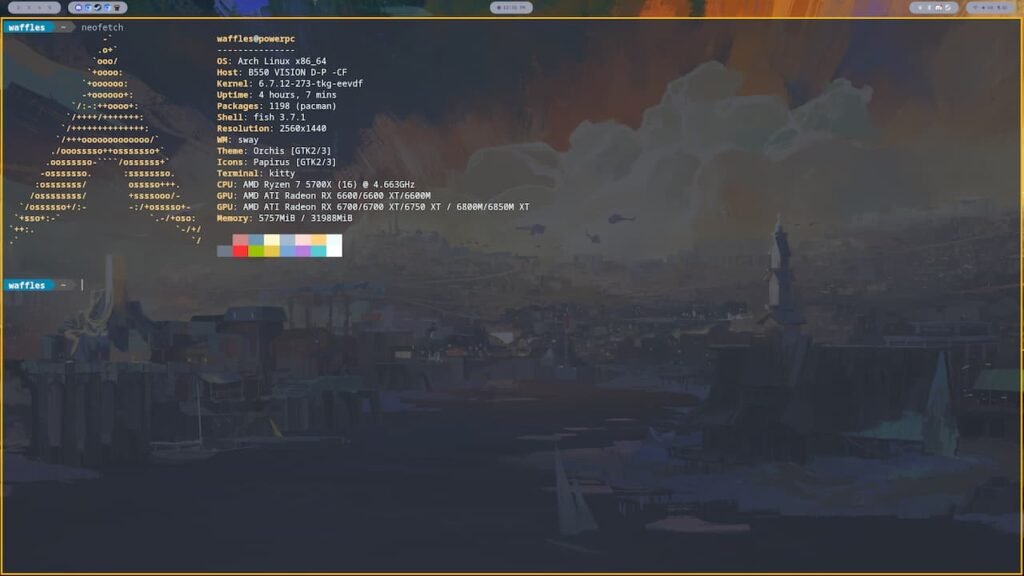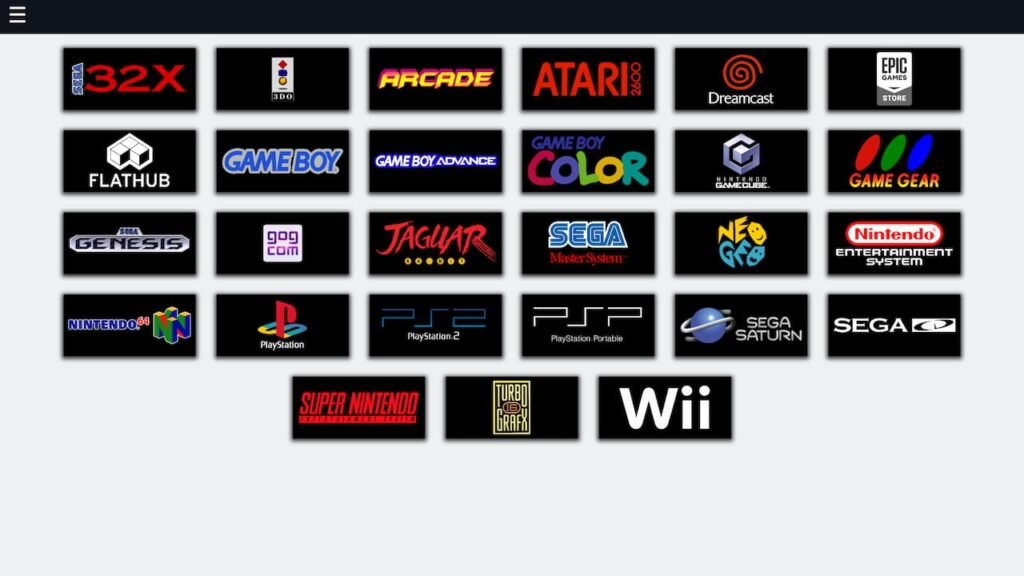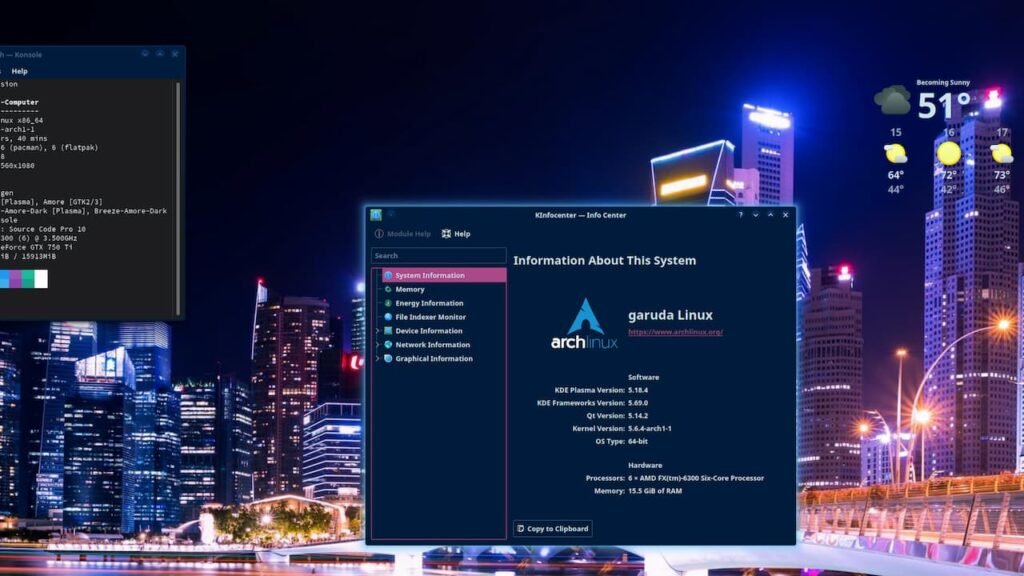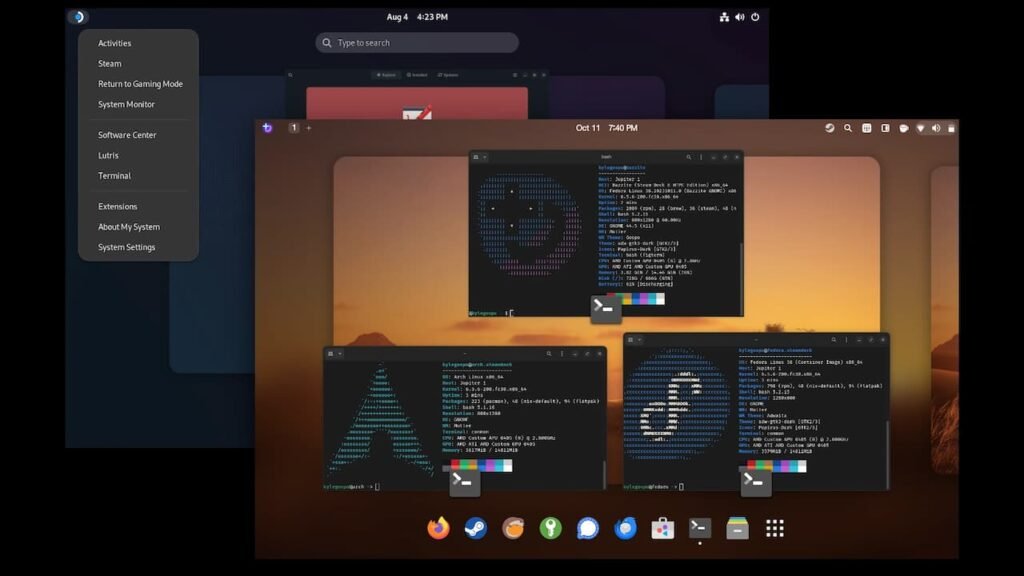While the year of the Linux desktop isn’t here just yet, Linus Torvalds’ brainchild has grown massively since its initial inception in 1991. The operating system is now used to power a variety of computers, ranging from home PCs to servers and gaming systems.
Gaming on Linux is just as seamless as on Windows, with superior performance being noted in certain cases – a result of the much lower overhead posed by the OS. This is not to say that there are no major pitfalls however – the most glaring of which is the hassle involved in setting up non-Steam games.
To this extent, the community has come forward to release multiple “gaming focused” Linux distros that offer a ton of pre-configured defaults and programs after the release of Valve’s own SteamOS.
7 of the best Linux gaming distros you should try out in 2024
1) Arch Linux

| System Requirements | |
| CPU | Any modern 64-bit CPU |
| RAM | 512 MB minimum |
| Storage | 800 MB minimum |
| GPU | Any modern compatible Nvidia/AMD/Intel Arc GPU |
Arch Linux is one of the most popular Linux distros available currently, and with good reason – it offers a ton of customizability and user control, in addition to bleeding edge updates. Arch can be configured to run as a very capable Linux gaming distro, with the addition of packages such as Steam, gamescope and others.
In fact, a good chunk of the popular gaming-oriented Linux distros are based on Arch, such as Valve’s own SteamOS. The bleeding edge packages on offer include performance mods and bug fixes which would otherwise be absent from distros such as Debian.
However, given the general difficulty of setting up a vanilla Arch install, and of the instabilities associated with the same, it scores a much lower position in this list.
2) ChimeraOS

| System Requirements | |
| CPU | Any modern 64-bit CPU |
| RAM | 4 GB minimum |
| Storage | 20 GB minimum |
| GPU | Any modern compatible AMD GPU. Nvidia and Intel GPUs are unsupported. |
Based on Arch Linux, ChimeraOS brings with it several additions and quality-of-life improvements over its foundation. ChimeraOS is specifically developed for HTPCs and handheld gaming PCs (such as the ROG Ally and Lenovo Legion Go), offering a SteamOS-like interface on top of the Gnome desktop.
The distro also ships with an easy to use installer, which is very much appreciated. ChimeraOS isn’t exactly a pure Arch experience however, as it comes pre-bundled with extra packages (including git versions of default Arch programs) that makes it stand out on its own.
However, it is entirely possible to use the AUR with the use of two simple commands – at the risk of breaking your installation. This step should be left to the more advanced users. A huge con of ChimeraOS is that it follows an atomic update system, which wipes data outside of the /etc and /home partitions after each update.
3) Garuda Linux

| System Requirements | |
| CPU | Any modern 64-bit CPU |
| RAM | 4 GB minimum |
| Storage | 30 GB minimum |
| GPU | Any modern compatible AMD/Nvidia/Intel Arc GPU |
Yet another Linux gaming distro based on Arch, Garuda Linux is a great general use OS that can double as a gaming OS. Unlike ChimeraOS, Garuda is not atomic, and features traditional updates – along with having unrestricted access to the AUR via the yay helper.
Despite being advertised as a “gaming” distro, Garuda is perfectly usable as a daily driver, and comes bundled with the (optional) rather excellent KDE desktop making it perfect for Windows users to transition from.
However, Garuda can be a bit more involved than ChimeraOS in its update and maintenance processes (given that it is a full-fledged desktop OS).
4) Bazzite

| System Requirements | |
| CPU | Any modern 64-bit CPU |
| RAM | 4 GB minimum |
| Storage | 30 GB minimum |
| GPU | Any modern compatible AMD/Nvidia/Intel Arc GPU. AMD is highly recommended. |
Unlike the previous entries within this list, Bazzite is based on Fedora instead of Arch Linux. This doesn’t change its usability however, as Bazzite uses certain bleeding edge components in its builds – much like Arch.
Bazzite is more akin to ChimeraOS in that it is built for HTPCs and handheld gaming devices in mind. The OS comes pre-configured with a SteamOS-like interface, on top of the very popular KDE/Gnome desktops, allowing for both gaming and general usage (such as word processing).
Unfortunately, Bazzite is also an Atomic distro, and thus nukes most partitions during an update.
5) Nobara Linux

| System Requirements | |
| CPU | Any modern 64-bit CPU |
| RAM | 2 GB minimum |
| Storage | 30 GB minimum |
| GPU | Any modern compatible AMD/Nvidia/Intel Arc GPU. AMD GPUs are highly recommended. |
Nobara Linux is a custom version of Fedora Linux, built by none other than the man behind Proton-GE, GloriousEggroll himself. Nobara incorporates the best of what Fedora has to offer, compiled with bleeding edge software for gamescope and mesa – among others.
While Nobara is advertised as a Linux gaming distro, it is entirely possible to use it for your main desktop. There are also a multitude of ways to customize your install, thanks to the built-in app installer available via both KDE Discover and Nobara’s own software suite.
Nobara is more like a traditional Linux distro, and does not have atomic properties making it quite suitable for desktops.
6) Fedora Linux

| System Requirements | |
| CPU | 2 GHz Dual Core |
| RAM | 2 GB |
| Storage | 10 GB |
| GPU | AMD, Nvidia and Intel GPUs are supported |
Fedora Linux is a long-running Linux distribution provided by the Fedora Project. Developed in 2003 as a part of coordinated efforts to continue the Red Hat Linux project, it has since gained mainstream appeal and grown to be the source of most Red Hat Linux distributions.
Fedora earns an easy recommendation in this list, thanks to its wide install base and abundance of software support. While not as bleeding edge as Arch Linux, Fedora does possess very up to date packages that make it especially good for gaming.
Coupled with the generally increased stability of the Fedora base over Arch, it should really come as no surprise that it is the preferred Linux distribution of choice for most users – including Linus Torvalds himself.
7) CachyOS

| System Requirements | |
| CPU | 1 GHz |
| RAM | 3 GB |
| Storage | 30 GB |
| GPU | Modern AMD, Nvidia or Intel GPUs |
CachyOS is a relatively new, Arch-based Linux distribution. CachyOS is razor focused on gaming, opting to use a set of custom CPU schedulers and extra packages to achieve best results.
Thanks to being built on top of Arch Linux, CachyOS receives bleeding edge updates, all while coming packaged in a handy GUI installer that simplifies the whole process. It is available in a variety of flavors, including specialized handheld gaming PC ISOs (such as for the Steam Deck and ROG Ally).
Overall, while there are a ton of Linux gaming distros to choose from, potential users will have to choose between the ease of an atomic update system or the more complicated, but powerful traditional Linux install.
Of these, Nobara Linux remains the best choice for both newcomers and veterans alike, thanks to its ease of use, coupled with bleeding edge hardware support. Bazzite is also a viable alternative for most users – provided they possess supported hardware.
